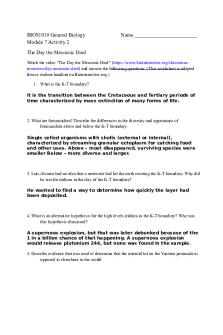Lemoine Module 7 Activity 1 The Day the Mesozoic Died Activity PDF

| Title | Lemoine Module 7 Activity 1 The Day the Mesozoic Died Activity |
|---|---|
| Author | Joe Lemoine |
| Course | General Biology |
| Institution | Metropolitan Community College, Nebraska |
| Pages | 2 |
| File Size | 69.8 KB |
| File Type | |
| Total Downloads | 21 |
| Total Views | 137 |
Summary
Lemoine Module 7 Activity 1 The Day the Mesozoic Died Activity...
Description
BIOS1010 General Biology Module 7 Activity 2
Name ________________________
The Day the Mesozoic Died Watch the video “The Day the Mesozoic Died” (https://www.biointeractive.org/classroomresources/day-mesozoic-died) and answer the following questions. (This worksheet is adapted from a student handout on Biointeractive.org.) 1. What is the K-T boundary? It is the transition between the Cretaceous and Tertiary periods of time characterized by mass extinction of many forms of life.
2. What are foraminifera? Describe the differences in the diversity and appearance of foraminifera above and below the K-T boundary. Single celled organisms with shells (external or internal), characterized by streaming granular ectoplasm for catching food and other uses. Above – most disappeared, surviving species were smaller Below – more diverse and larger.
3. Luis Alvarez had no idea that a meteorite had hit the earth creating the K-T boundary. Why did he test for iridium in the clay of the K-T boundary? He wanted to find a way to determine how quickly the layer had been deposited.
4. What is an alternative hypothesis for the high levels iridium in the K-T boundary? Why was this hypothesis dismissed? A supernova explosion, but that was later debunked because of the 1 in a billion chance of that happening. A supernova explosion would release plutonium 244, but none was found in the sample. 5. Describe evidence that was used to determine that the asteroid hit on the Yucatan peninsula as opposed to elsewhere in the world.
Shock quartz was found in Penfield’s rock samples from the Chicxulub crater, showing high energy impact occurred. 6. Describe how life on the planet was different after the asteroid hit both during the first million years and then after the first million years. Fire and smoke blocked the sun immediately following the asteroid and left anything that was dependent on photosynthesis (plants) to die as well as food chains to collapse. 60% of all plant species went extinct, but eventually a spike in ferns happened and grew throughout the land. After the first million years, animals started to populate the environment again, mainly small animals, that could’ve survived the asteroid such as birds, rodents, turtles, frogs, swamp and river creatures, or animals near the seashore.
7. What do you think life on earth would be like now if the asteroid had not struck the earth? I think it’s very hard to imagine a world without that occurrence. I do believe dinosaurs would still be very prevalent, and there wouldn’t be nearly as many species of other animals and I also don’t believe the Earth would be as over populated with humans as it is today because of the dominance dinosaurs would have over all other living things. 8. The K-T event was only one of five major extinction events in the history of earth. Do some research and find out when the other four events occurred and what scientists think caused them. End Ordovician – 444 million years ago, took out 86% of species caused by an ice age Late Devonian – 375 million years ago, took out 75% of species caused by changes in the land due to evolving plants and changes in the oceans End Permian – 251 million years ago, took out 96% of species caused by a cataclysmic eruption near Siberia that released CO2 into the atmosphere End Triassic – 200 million years ago, took out 80% of species and the cause was never found...
Similar Free PDFs

The Day the Mesozoic Died 7 24
- 2 Pages

HIM 500- Module 7 Activity
- 4 Pages

Activity-1-1 - ACTIVITY
- 9 Pages

7-1 Activity - classwork
- 4 Pages

The philosophical activity
- 10 Pages

Label The Heart Activity
- 2 Pages

The Lorax Activity Answers
- 4 Pages

Ready Module 4 Activity 1
- 3 Pages

Lemoine Module 2 Lab 1
- 13 Pages

Activity 8 AN Unforgettable DAY
- 2 Pages

Culminating Activity Module 3
- 2 Pages
Popular Institutions
- Tinajero National High School - Annex
- Politeknik Caltex Riau
- Yokohama City University
- SGT University
- University of Al-Qadisiyah
- Divine Word College of Vigan
- Techniek College Rotterdam
- Universidade de Santiago
- Universiti Teknologi MARA Cawangan Johor Kampus Pasir Gudang
- Poltekkes Kemenkes Yogyakarta
- Baguio City National High School
- Colegio san marcos
- preparatoria uno
- Centro de Bachillerato Tecnológico Industrial y de Servicios No. 107
- Dalian Maritime University
- Quang Trung Secondary School
- Colegio Tecnológico en Informática
- Corporación Regional de Educación Superior
- Grupo CEDVA
- Dar Al Uloom University
- Centro de Estudios Preuniversitarios de la Universidad Nacional de Ingeniería
- 上智大学
- Aakash International School, Nuna Majara
- San Felipe Neri Catholic School
- Kang Chiao International School - New Taipei City
- Misamis Occidental National High School
- Institución Educativa Escuela Normal Juan Ladrilleros
- Kolehiyo ng Pantukan
- Batanes State College
- Instituto Continental
- Sekolah Menengah Kejuruan Kesehatan Kaltara (Tarakan)
- Colegio de La Inmaculada Concepcion - Cebu




